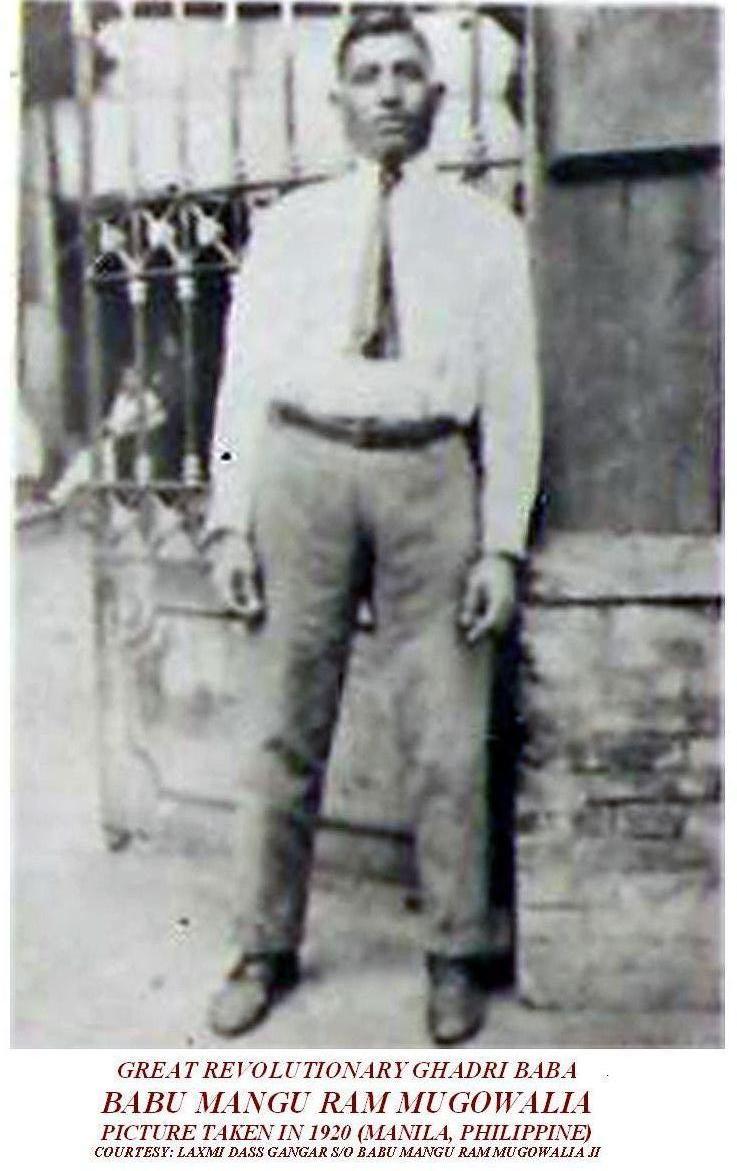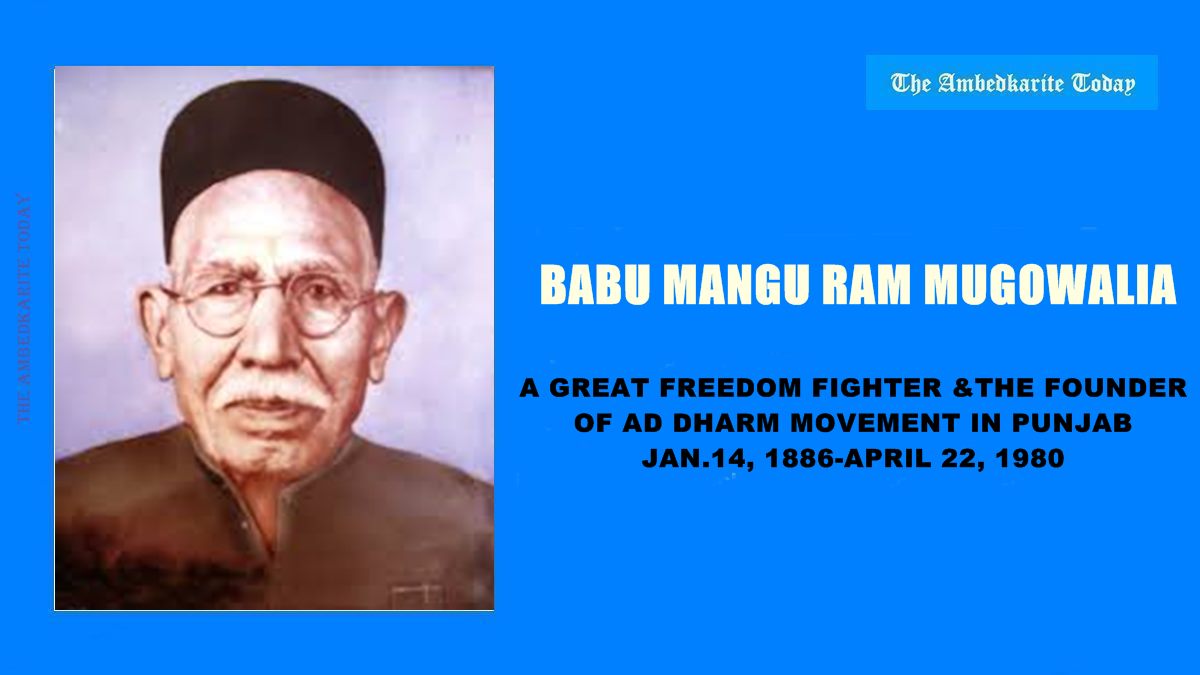Babu Mangoo Ram was born on January 14, 1886 , in village Mugowal, Hoshiarpur district, where this father,Harman Dass, had left the traditional Chamar caste occupation of training and preparing hides and attempting to sell tanned hides commercially.
Mangoo Ram’s mother, Atri, died when Mangoo Ram was three, so the father began to depend heavily on his sons – Mangoo and an older and a younger brother for assistance. Because the leather trade required some facility in English, Mangoo Ram’s father was forced to rely on literate members of upper castes to read sales orders and other instructions to him. In payment for their reading instructions for an hour, he would have to do a day of crude labour. For that reason, Mangoo Ram’s father was eager to have his son receive an early education.

Founder of Ad-Dharmi Movement
When Mangoo Ram was seven, he was taught by a village Sadhu (Saint) and soon after attended a variety of schools in the Mugowal area (Tehsil Mahilpur of district Hoshiarpur). He also attended school in a village near Dehra Dun , where his older brother has settled. In most of the schools, Mangoo Ram was the only Scheduled Caste student. He sat at the back of the class, or even in a separate room, and listed through the open door. When he attended high school in Bajwara, he was forced to stay outside the building and listen to the classes through the windows. Once when he came inside during a heaving hailstorm, the Braham teacher beat him and put all the classroom furniture, which he had “polluted” by his presence, outside in the rain to be literally and ritually washed clean. Nonetheless, Mangoo Ram was a good student: he placed third in his class in primary school. But whereas the other good students were encouraged to become patwaris (village record-keeper) or to seek higher education, Mango Ram was encouraged to leave school and help his father at a more proper “Chamar task”. In 1905, he did quit school; he married, and for three years helped his father develop their leather trade into a thriving business.
In 1909 America as in the air. Scores of upper caste farmers from Mangoo Ram’s area of Hoshiarpur had gone to the United States , and those who had not gone were talking about it. Mangoo Ram decided to go also. He persuaded his father that it would be good for the business – he would send money back from America – and his father responded by giving him some savings from the family business. Amid assurances from some of the local Zamindars (“landowners”) and two Chamar friends set off for the new world.2
The friends turned back, but Mangoo Ram persevered and arrived in California late in 1909. For four years he picked fruit for the former Zamindars of his village who had settled in the San Joaquin valley of California . He was also employed in a sugar mill. Mangoo Ram lived first in Fresno , then in Stockton , Sacramento , EL Centro , Vacaville , Visalia , and again in Fresno.3. He did indeed make money and set his savings home.

In 1913 some of the Punjabi settlers in California were forming a militant nationalist organisation. Mangoo Ram joined this group, the Ghadar movement, as a full-time worker in San Francisco . He was struck by the fact that, as he was later to say, “it was a new society; we were treated as equal”4. There were not many Scheduled Caste persons in the Ghadar movement, however; Mangoo Ram recalls only one other Chamar besides himself.
Initially Mangoo Ram played only a minor role in the organisation,, but in 1915 he volunteered to be one of five Ghadrites to participate in a dangerous mission involving smuggled weapons shipped from California to the Punjab . He was chosen for the task by the main whom he identifies as the “leader of the Ghadar” party at that time.” Sohan Singh Bakhna5. The secretary of the Los Angeles where they boarded an intermediary boat after collecting all their personal identification. For the rest of the saga, Mangoo Ram would be known by a Muslim pseudonym, Nizamuddin.
According to Mangoo Ram, the intermediary boat took them to the Socorro (sic) islands to rendezvous with the weapons boat, but after thirteen days military shop from Sydney, the “Man of War”, discovered the timely intervention of an American warship were they spared. They went to Vera Cruz, Mexico , to receive rations.
There they finally connected with their weapons boat, the Maverick; they joined the crew, took on giant turtles for food, and headed for India.7 They were halted again in Hawaii , where Mangoo Ram witnessed the eruption of volcanoes. Free again, they advanced a bit further, perhaps to Java or New Caledonia.8. There the Japanese, on behalf of the British, imprisoned them for one year. Eventually, the British decided to hang them, but at midnight the night before they were to be hanged at dawn, fate intervened. The Germans spirited them away in the dark, and the five went their separate directions – Harmans Dass and Charan Dass to Bangkok ; the others, including Mangoo Ram, to Manila .
But again, according to Mangoo Ram’s memory, the intervention of fate altered their plans. A typhoon appeared, and the ship went to Singapore instead, where British spies, Bela Singh and Bhag Singh, turned Mangoo Ram over to British authorities, who promptly ordered him to be placed before a cannon and shot. Again, however, the Germans whisked Mangoo Ram away, and again he was placed on a ship bound for Manila.9. When Mangoo Ram arrived in the Philippines he read a news report in the Manila Times indicating that he had been executed for treason b the British in Singapore . Mangoo Ram assumes that one of his captured colleagues had taken on his name to protect him, and that that man had been shot in his place. The news of his alleged death preceded him to the Punjab , where his wife heard the report and promptly married his younger brother, as custom dictated. In the meantime, Mangoo Ram was sequestered in the Philippines in a series of hideouts on various islands. Members of the Ghadar party were his benefactors during this period, and Mangoo Ram remembers fondly their hospitality and friendship: he was no longer an Untouchable but a comrade in distress.10.
The war ended in 1918, the Ghadar party was no longer quite the threat its was earlier when it enraged the British by compounding separatism with sedition through its liaison with the Germans. But Mangoo Ram decided to stay in Manila nonetheless. He met an American, a Mr Johnson of Marshall Field and Company (a department store in Chicago ), who hired him to work in an
Early in 1925 he set sail, this time on a more pleasant and uninterrupted trip. He arrived in Ceylon in the company of a Christian missionary he had met on board, then travelled through the subcontinent to the Punjab , visiting Madurai , Madras , Bombay , Poona , Sitara, Nagpur , and Delhi . He observed the conditions of the Scheduled Castes en route and was dismayed “to se our people being treated to badly”.12. At the Minaksi Temple in Madurai , for instance, he was told to be careful not to touch the Achhut (Untouchables): people assumed from his dress that he was of decent caste. By the time Mangoo Ram reached the Punjab he was convinced that there was need for social change, and wrote to Ghadar Party headquarters in San Francisco about the difficult conditions of the Scheduled Castes in India , announcing that their freedom was more important to him than that of the nation itself. According to Mangoo Ram, leaders of the Ghadar party at that point designated him to work for the uplift of the Untouchables 13. Thus, in a new context, the old revolutionary from Fresno continued the Ghadar spirit.
Late in 1925, after his return to the Punjab , Mangoo Ram began teaching in a primary school in his home village of Mugowal , a school which Mangoo Ram claims he named the Ad Dharm School. It was in that school, on June 11 and 12 1926, that Mangoo Ram convened the meeting that formally launched the Ad Dharm movement. Mangoo Ram was elected its first president, a title he was retained for the duration of the movement. Om November 1926, when the Ad Dharm organisation opened an office in the city of Jullundhar , Mangoo Ram took up residence there, where he remained until he became active in politics in the 1940s, at which point he moved to the town of Hoshiarpur . Later, the newly independent government of India presented him with some land near Garhshankar, not for away, which developed into a small farm.
In 1977, after the Ad Dharm movement had been re-established, and Mangoo Ram had been again elevated to leadership of the movement, his supporter sent him on a triumphant tour of communities of expatriate lower caste Punjabis in Great Britain . It was Mangoo Ram’s first major voyage since returning from America , half a century before. For him the occasion was one of nostalgia, but also one of completeness, for it enabled him to mark the closing phase of his long public career with a trip abroad, just as he had opened it in a similar way many years before. It was to be the last great event before his death on April 22, 1980 , at the age of 94.
The pattern of expatriate experience leading to nationalism and political activism when the expatriates return home is replicated in the personal histories of other leaders: the lives of Gandhi, Sri Aurobindo Ghose, Dr. B.R Ambedkar, the Ghadar militants, and other Third world figures such as Kwame Nkrumah and Ho Chi Minh. Seldom, however has a personal history held such dramatic extremes- from leadership in a secular movement to leadership in a religious one, from an anti-British to a pro-British stance (and then back again), from being a banished Untouchable to being an imposing political figure. The sheer diversity of Mangoo Ram’s colourful life would invalidate any claims he might have wanted village culture of the lower castes, but experience forged him into a modern man. Ultimately, his characteristics were modern were those of the movement he led and of the proud new breed of ex-Untouchable he came to represent.
Source – Ambedkartimes

